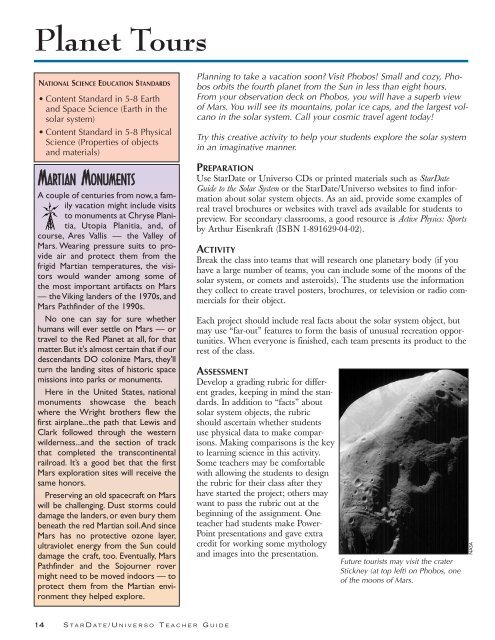You also want an ePaper? Increase the reach of your titles
YUMPU automatically turns print PDFs into web optimized ePapers that Google loves.
Planet Tours<br />
NATIONAL SCIENCE EDUCATION STANDARDS<br />
• Content Standard in 5-8 Earth<br />
and Space Science (Earth in the<br />
solar system)<br />
• Content Standard in 5-8 Physical<br />
Science (Properties of objects<br />
and materials)<br />
MARTIAN MONUMENTS<br />
A couple of centuries from now, a family<br />
vacation might include visits<br />
to monuments at Chryse Planitia,<br />
Utopia Planitia, and, of<br />
course, Ares Vallis — the Valley of<br />
Mars. Wearing pressure suits to provide<br />
air and protect them from the<br />
frigid Martian temperatures, the visitors<br />
would wander among some of<br />
the most important artifacts on Mars<br />
— the Viking landers of the 1970s, and<br />
Mars Pathfinder of the 1990s.<br />
No one can say for sure whether<br />
humans will ever settle on Mars — or<br />
travel to the Red Planet at all, for that<br />
matter. But it's almost certain that if our<br />
descendants DO colonize Mars, they'll<br />
turn the landing sites of historic space<br />
missions into parks or monuments.<br />
Here in the United States, national<br />
monuments showcase the beach<br />
where the Wright brothers flew the<br />
first airplane...the path that Lewis and<br />
Clark followed through the western<br />
wilderness...and the section of track<br />
that completed the transcontinental<br />
railroad. It’s a good bet that the first<br />
Mars exploration sites will receive the<br />
same honors.<br />
Preserving an old spacecraft on Mars<br />
will be challenging. Dust storms could<br />
damage the landers, or even bury them<br />
beneath the red Martian soil.And since<br />
Mars has no protective ozone layer,<br />
ultraviolet energy from the Sun could<br />
damage the craft, too. Eventually, Mars<br />
Pathfinder and the Sojourner rover<br />
might need to be moved indoors — to<br />
protect them from the Martian environment<br />
they helped explore.<br />
Planning to take a vacation soon Visit Phobos! Small and cozy, Phobos<br />
orbits the fourth planet from the Sun in less than eight hours.<br />
From your observation deck on Phobos, you will have a superb view<br />
of Mars. You will see its mountains, polar ice caps, and the largest volcano<br />
in the solar system. Call your cosmic travel agent today!<br />
Try this creative activity to help your students explore the solar system<br />
in an imaginative manner.<br />
PREPARATION<br />
Use StarDate or Universo CDs or printed materials such as StarDate<br />
Guide to the Solar System or the StarDate/Universo websites to find information<br />
about solar system objects. As an aid, provide some examples of<br />
real travel brochures or websites with travel ads available for students to<br />
preview. For secondary classrooms, a good resource is Active Physics: Sports<br />
by Arthur Eisenkraft (ISBN 1-891629-04-02).<br />
ACTIVITY<br />
Break the class into teams that will research one planetary body (if you<br />
have a large number of teams, you can include some of the moons of the<br />
solar system, or comets and asteroids). The students use the information<br />
they collect to create travel posters, brochures, or television or radio commercials<br />
for their object.<br />
Each project should include real facts about the solar system object, but<br />
may use “far-out” features to form the basis of unusual recreation opportunities.<br />
When everyone is finished, each team presents its product to the<br />
rest of the class.<br />
ASSESSMENT<br />
Develop a grading rubric for different<br />
grades, keeping in mind the standards.<br />
In addition to “facts” about<br />
solar system objects, the rubric<br />
should ascertain whether students<br />
use physical data to make comparisons.<br />
Making comparisons is the key<br />
to learning science in this activity.<br />
Some teachers may be comfortable<br />
with allowing the students to design<br />
the rubric for their class after they<br />
have started the project; others may<br />
want to pass the rubric out at the<br />
beginning of the assignment. One<br />
teacher had students make Power-<br />
Point presentations and gave extra<br />
credit for working some mythology<br />
and images into the presentation.<br />
Future tourists may visit the crater<br />
Stickney (at top left) on Phobos, one<br />
of the moons of Mars.<br />
NASA<br />
14 S TARD ATE/UNIVERSO T EACHER G UIDE
Subjects: Our Solar System<br />
Grade Levels: 6-8<br />
Planet Tours<br />
In this creative activity, students learn about an object in our solar<br />
system and create a travel brochure or advertisement to attract future<br />
space tourists to their exotic destination. Engages students with both<br />
facts and imagination.<br />
Texas Essential Knowledge and Skills<br />
Science, 6-8:<br />
§112.18 grade 6 (b) - (11) (A) describe the physical properties,<br />
locations, and movements of the Sun, planets, Galilean moons,<br />
meteors, asteroids, and comets.<br />
§112.19 grade 7 (b) - (9) (A) analyze the characteristics of objects in<br />
our solar system that allow life to exist such as the proximity of the<br />
Sun, presence of water, and composition of the atmosphere<br />
© April 2011 The University of Texas at Austin













